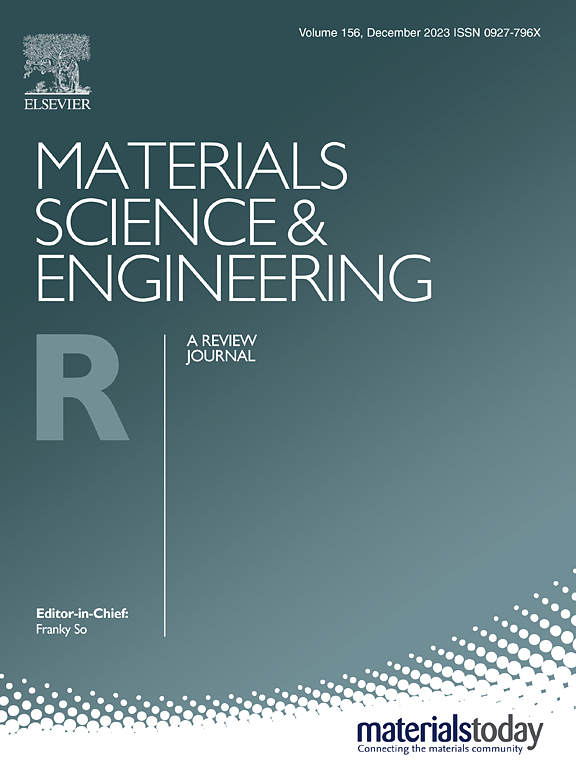用于储能设备水性电解质的氧化还原活性分子:基础方面、当前进展和前景综述
IF 31.6
1区 材料科学
Q1 MATERIALS SCIENCE, MULTIDISCIPLINARY
引用次数: 0
摘要
人们对具有高能量密度、更大电压窗口和更长循环稳定性的水性储能(AES)解决方案的需求与日俱增,这推动了先进电解质的发展。氧化还原活性分子有望配制出电化学性能更强的水基电解质。在这篇综述中,我们全面概述了针对 AES 器件的氧化还原电解质的既有研究和最新报道。本综述深入探讨了分子和微米尺度的机制,涵盖了电解质的基本原理,包括其物理化学特性、离子溶解行为、界面调制和传输机制。我们概述了不同系列的各种化合物的氧化还原特性。虽然不可逆的电子/质量转移过程可以促进固体电解质界面的钝化,但我们特别关注可逆氧化还原电解质在提高 AES 系统能量性能方面的作用。氧化还原活性分子可根据其改善电极循环稳定性、增加电解质电压窗口和提高电池能量密度的能力进行分类。高溶解度和可逆氧化还原行为是通过分子设计实现的。文中讨论了穿梭效应和电解质改性之间的权衡以及分子溶解度方面的争议。通过研究这些方面,本综述旨在促进氧化还原活性分子在 AES 技术方面的高级研究。本文章由计算机程序翻译,如有差异,请以英文原文为准。
Redox-active molecules for aqueous electrolytes of energy storage devices: A review on fundamental aspects, current progress, and prospects
The increasing demand for aqueous energy storage (AES) solutions with high energy density, enlarged voltage windows, and extended cycling stability has spurred the development of advanced electrolytes. Redox-active molecules hold the promise for formulating aqueous electrolytes with enhanced electrochemical performance. In this review, we provide a comprehensive overview of established and recently reported studies on redox electrolytes for AES devices. Delving into mechanisms at both molecular and micrometer scales, this review covers the fundamental principles governing the electrolytes, encompassing their physicochemical properties, ion solvation behavior, interfacial modulation, and transport mechanisms. We present an overview of the redox properties of various compounds from different families. While irreversible electron/mass transfer processes can facilitate the passivation of solid electrolyte interfaces, particular attention is given to the reversible redox electrolyte in enhancing the energy performance of AES systems. Redox-active molecules are categorized based on their ability to improve the cycling stability of electrodes, increase the voltage windows of electrolytes, and enhance the energy density of cells. High solubility and reversible redox behavior have been achieved via the molecular design. Trade-offs between the shuttling effect and electrolyte modification as well as controversies on molecular solubility are discussed. By examining these aspects, the review aims to stimulate advanced research in redox-active molecules for AES technologies.
求助全文
通过发布文献求助,成功后即可免费获取论文全文。
去求助
来源期刊

Materials Science and Engineering: R: Reports
工程技术-材料科学:综合
CiteScore
60.50
自引率
0.30%
发文量
19
审稿时长
34 days
期刊介绍:
Materials Science & Engineering R: Reports is a journal that covers a wide range of topics in the field of materials science and engineering. It publishes both experimental and theoretical research papers, providing background information and critical assessments on various topics. The journal aims to publish high-quality and novel research papers and reviews.
The subject areas covered by the journal include Materials Science (General), Electronic Materials, Optical Materials, and Magnetic Materials. In addition to regular issues, the journal also publishes special issues on key themes in the field of materials science, including Energy Materials, Materials for Health, Materials Discovery, Innovation for High Value Manufacturing, and Sustainable Materials development.
 求助内容:
求助内容: 应助结果提醒方式:
应助结果提醒方式:


